September 20th, 2010 · No Comments
I think it will be beating a dead horse at this point to talk about the lack of diversity in the National Portrait Gallery, but I guess I have to a little bit, so sorry horsey. Truthfully, the whole politically correct, inclusive way of thinking about representation is a late 20th century idea. Until that time, when the movement towards serious examination of who is telling/included in the historical narrative was underway, the rich white male’s story was the story, and if it was questioned, it wasn’t questioned openly. So, it was no surprise to me to see walls covered in portraits of the aristocracy and the very famous movers and shakers, and to see no portraits of the poor, lower classes, or racial minorities. (It’s important to note that portraits were mainly done by commission, and to sit for a portrait was time consuming. The lower classes wouldn’t have been able to afford or have the leisure time to have their portraits painted.)
I was, however, surprised by the number of portraits of women I saw. Still not as many as men, but much more than I was expecting. One portrait in particular that caught my attention was the self-portrait of Mary Beale.

Mary Beale, by Mary Beale, oil on canvas circa 1665 (Image from the National Portrait Gallery website)
I was immediately drawn to the richness and depth of the color (this is much more apparent in person). The draping of the Beale’s crimson and steely-plum silk dress suggests a solid, strong body beneath. Her expression is self-assured, yet humble, and she appears competent and adept. After admiring the painting for purely aesthetic reasons, I was even more interested when I read the accompanying text.
Beale worked as a professional painter from the mid-1650s, specializing in portraiture. She was the first Englishwoman to become a portrait painter of real distinction. A daughter of a Suffolk clergyman, by age 27 Beale was a very much in-demand portraitist, particularly for the clergy. Beale’s husband Charles, whom she married at age 19, was also a painter, and he acted as a studio assistant to Beale as well as kept records of all of her commissions. In the self-portrait above, a painter’s palette hangs on the wall in the background, referencing her profession, and she holds in her hand a canvas depicting her two sons, Bartholomew (1656-1709) and Charles (1660-1726).
It was so satisfying to see in the National Portrait Gallery a portrait of woman who was valued for something more than royal or aristocratic blood, or being a wife or mistress to someone of royal or aristocratic blood. How incredibly progressive, in the 17th century no less, for a woman to be honored and admired for her work as something other than being a madonna or a whore. To me, Mary Beale resembles quite closely the “ideal” modern woman. She was a wife and mother, but she was also a respected, talented, accomplished career woman, and that is what takes the historical precedence.
Reference:
Schubert, Gudrun. “Beale, Mary.” In The Oxford Companion to Western Art, edited by Hugh Brigstocke. Oxford Art Online, http://www.oxfordartonline.com/subscriber/article/opr/t118/e213 (accessed September 20, 2010).
Tags: 2010 Rachel
September 20th, 2010 · No Comments
London’s public parks are impressive, in their size, beauty, and sheer number. Most people go to these parks to play sports, have picnics, hang out with their mates (both kinds), sit and read under a tree, etc., but my favorite park activity is people watching; and nowhere in London is the people watching better than in Hyde Park’s Speaker’s Corner. Speaker’s Corner is like an internet chat forum come to life, attracting people from every imaginable social background and point of view. Immaculately dressed women toting around their four figure handbags walk by elderly Sikh men in skull caps with long, gray beards. Middle school aged children in football jerseys weave between bikers and joggers. Indian grandmas in wheelchairs are pushed by their grandkids past punk teenagers in six inch platform boots. London’s parks truly attract all kinds, and Speaker’s Corner is the ideal place to find a varied audience if you have something to say, simply set up your little stool, hop on, and begin your diatribe against the government, the media, the cursed masses, who or whatever. If you have anything even remotely interesting to say, a crowd will soon form around you. Wearing a funny costume doesn’t hurt either, the crazier the better.

Just a guy feeding the pigeons. (personal photo)
I’ve simply strolled through most of the parks here, stopping every now and then to admire a flower or dodge a pile of dog poop, but Hyde Park caught my attention and kept it. Right across from the tail end of the Oxford St. madness you will find the Marble Arch, and beyond it a massive expanse of green space. Speaker’s Corner is lodged conveniently in the middle. The first character I encountered was a militant African man speaking out against the war in Iraq. He looked to be about 25 or so, and around him stood a rather sizable crowd. There was also a group of four physically fit 20 somethings advertising a personal training service and attracting quite a crowd with their boxing gimmick. One of the men held up a pad on each hand and challenged people in the crowd to get in 200 punches in one minute. A group of south asian men egged each other on in friendly competition as the crowd laughed and cheered. I was asked to participate, but declined the request. After I had had my fill of watching overweight middle-aged men try and fail to show off athletic prowess, I moved over to listen to a capital C Crazy preacher and the bemused, laughing, and heckling crowd around him.

Belligerent preacher pointing at me and asking me something silly like if I knew where I was going when I died. (personal photo)
My favorite speaker was a grizzled old man sartorially channeling the Gorton’s Fisherman. He had a much smaller crowd around him, an interesting mix of homeless people and business men in suits and ties, and me. He wasn’t so much Speaking as having an intimate conversation with his little crowd, discussing poetry and painting, interspersed with personal anecdotes of questionable validity.
Past all of this, Hyde Park is like all the rest, and if you walk in far enough you will undoubtedly be able to stake out your own patch of serenity. Muslin women in full burkas sit and read, couples sit shoulder to shoulder on blankets, its all really a very nice scene. I guess the behavior in the park could be described as English, in that, aside from the liminal space of Speaker’s Corner, people seem to keep themselves, on the whole, its all very orderly.
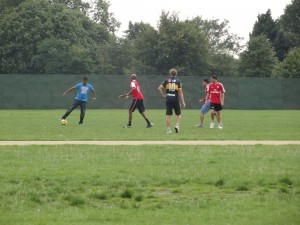
Mates playing a bit of footie. (personal photo)
Tags: 2010 Rachel · Uncategorized
September 14th, 2009 · 3 Comments
Pub life in London. It has potential to be the great equalizer. A place where anyone over a certain age can enjoy a pint (or a glass of wine, or a mixed drink, or more than a pint…) of the drink of their choice and just chat with people inside the establishment. In the less tourist-filled places, pub life has the potential to really be a place where communities can come together. After a day at work, what could be better than grabbing some food and a drink with your neighbors while chatting with your co-workers and a friendly bartender? It sounds like an ideal way to cap off a day.
If only everyone really did enjoy it. Yes, the pub is open any and every one. But those who really are a part of the ‘authentic’ pub culture are, to this observer, those who hold on to the old British identity. Upon entering a pub, you’re sure to see a few men in suits in the corner getting drinks before heading home, a few young people on dates and chatting with friends, and a couple regulars in brown leather jackets who are talking with the bartenders about intimate details of their lives. Who isn’t there? The large Bangladeshi, Pakistani, and Indian populations, the tourists (they won’t be in until about 9 or 10 because they don’t quite realize the time that pub life really peaks over here), and the women who stay at home all aren’t present. I don’t think there are any fingers to point here. The pubs are open, anyone can come who wishes to, and the beverages offered all the same for all who walk through the door. Still, it’s a little disheartening that it is such a homogeneous group that composes such a recognizable part of British life. When you think pub, you think England. How frustrating that when you think pub culture, the image that pops up is that of such an un-diversified crowd.
That being said, I have thoroughly enjoyed all of my experiences with pubs. The food has always been great (though a bit pricey), the drinks have always been delicious, and I have always gotten some satisfaction out of asking for a pint. It seems like such a grown-up thing to do. And while I have always gone to pubs as a part of a large group of students who are all clearly tourists, I will say that I haven’t really gotten to interact with the ‘authentic’ British people present at the pubs. Yes, we are noisy tourists that are intruding on their pint time but I still am disappointed in the lack of experience I have with chatting with the locals at the pubs. That’s something I definitely want to enjoy in Norwich. I think that I’ll have to find myself in a group of people with natural accents for that to happen rather than a group of people in which the fake accents increase in strength in correlation with how many drinks they have. I’m guilty of the fake accent-ing just as much as anyone else on the trip. But I think that’s definitely a handicap in really getting to experience pub culture (if that’s even possible for a twenty-year old female to do- I’m not convinced that that’s a group that’s really accepted into ‘authentic’ pub culture. I’m interested to find out though). So, cheers for now and we’ll find out more in Norwich.
Tags: Audrey · Pubs
-

-
Christ Church and the Rugby Pitch
-
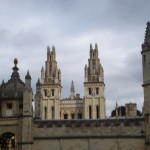
-
The University of Oxford
-
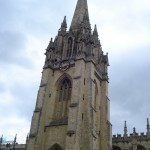
-
Cathedral
-
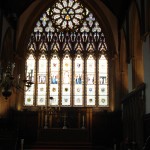
-
Chapel
Although this post is a bit belated I felt it was important to share my experience in Oxford last Saturday. After a relaxing hour train ride from Paddington Station to Oxford our class had some time to explore before our formal tour in the afternoon. Besides the university I did not know much about the town of Oxford going into the trip so naturally I was surprised to see huge mobs of people as I approached the main road. This sight immediately generated thoughts of the U.S. I felt like I could have just as easily been walking around Yaletown, New Haven or downtown Freeport with shopping centers and fast food restaurants lining the roads as far as the eye could see.
Anxious to get out of the bustling shopping area Brandon, Aidan and I followed our map down towards Christ Church, one of the many sites where the Harry Potter movies have been filmed. Since they were charging 3 pounds to enter the gates Brandon, Aidan and I decided to save our money and take pictures from the outside of the fantastic building. We walked around the back and found a long walkway that took us away further away from the town and back behind the university where we saw athletic fields and the magnificent Church in the distance. We decided to try to go to the Botanic Gardens only to find that the path was closed off and opted to head back towards the town instead.
Not to shift topics completely but lunch was an experience in itself. Brandon, Aidan and I entered a covered market that featured a variety of stores and small eateries. After walking throughout the market Aidan spotted a sandwich place that was selling pretty large sandwiches at a fairly affordable price. We decided to purchase sandwiches there despite the fact that there was no seating available in front of the eatery. Spotting a nearby cafe with 10-15 chairs available we decided that it looked like a promising spot to sit and enjoy our sandwiches. After about two bites we were approached by a random man who gave us a stern warning that we should not be sitting there since we did not buy the food from that eatery. He also mentioned something about needing room for he and his two kids to sit even though there were still ample chairs available. This man had no apparent connection to the restaurant, and no real reason to say anything to us. He simply just wanted to make his point known. Being the law abiding citizens we are we attempted to find another place to sit outside the market. After a few minutes of wandering we found a pizza express that appeared to be closed. Like the cafe there was plenty of seating outside and no business in sight. Sure enough however a woman emerged from the restaurant and told us we could not sit in front of the restaurant despite there being numerous seats available. Frustrated and a bit perturbed I held in my contempt and we attempted to find another place to sit. Due to the massive amounts of people on the streets none of the park benches were open so the three of us ended up eating our sandwiches in a back alley where no one could bother us for eating in front of their establishment.
If there is one pet peeve I have about London it’s that most restaurants don’t have enough places for people to sit and enjoy their food. In addition people become overly offended when you eat food you purchased elsewhere in front of another restaurant. It becomes a vicious cycle and leaves one with two options. The first option is to master the “walk and eat” technique which from keen observation it seems Londoners have figured out pretty well. The second option is to pull out the vagabond card and eat in a back alley or on the side of the street. Needless to say I have had to resort to the second technique quite a few times since my arrival in the U.K. Not to beat a dead horse but it seems to me that restaurants should provide enough seating for their clientele. In addition places that don’t have any business should be generous and allow anyone to eat outside their establishment. I know it goes against the rules of good business but personally I think the rules of common courtesy to fellow man are a bit more important…and with that I digress.
Between my distaste of downtown Oxford and my lunch experience I did not have a very good feeling going into the tour that afternoon. Thankfully this negative feeling would disappear once the tour got going. Our tour guide had the driest sense of humour I had ever encountered but he was very informative and knew a lot about the University of Oxford’s current setup as well as its history. Since I give tours for Dickinson and worked in the admissions office this past Summer my main interest while touring Oxford centered on how the British system of higher education differs from that of the states. I found it interesting that the British government actually requires Oxford to take up to 80 percent of its students from Public schools in the U.K. Traditionally institutions like Oxford and Cambridge have swept up private preparatory scholars like wildfire. Since Oxford is now being forced to take so many public school students I wonder how much the dynamic of the university has been changed. It was clear from what our tour guide said that there is a lot of distaste expressed by the University on this subject. Another thing that I found interesting about Oxford is how it was layed out into separate colleges which essentially function as completely separate institutions. Unlike the university system in the U.S. most of the colleges within Oxford offer classes in just about any subject area, almost like a collection of liberal arts colleges. Students actually apply for a specific college all of which have different traditions and reputations but are all considered part of The University of Oxford. The different colleges often compete against each other through both athletic and mental competitions and the best athletes from each college are chosen to compete on the University team, typically against Cambridge.
Walking around it was amazing to view architecture that was at least two times as old as Dickinson’s. The juxtaposition between the modern, tourist trap of a town and the old, traditional university was striking. Since the town seemed to be completely catered to the 21st century student I had a hard time believing him when our tour guide said that the town/gown relationship needed some improvement.
Overall I enjoyed the tour of the University of Oxford a lot. Although I am extremely lucky to be a student at a school like Dickinson and also fortunate to be attending UEA this year I can’t help but wonder what it would be like to attend Oxford. There is just so much history and tradition there and an unbelievable amount of prestige. I hope that when we visit Cambridge it offers a similar experience.
To compare Oxford to London would be like comparing apples and oranges. I noticed a much different, more touristy, less ethnically diverse and less friendly population at Oxford. As I continue to spend time in England I realize more and more that London seems to be an incredibly unique area within the entire country. As we move from the bubble of London to the countryside of Norwich next week I will be interested to see how Norwich fits in the grand scheme of things. What type of diversity will we experience among the student population at UEA and the Norwich population in general? These are questions that will remain unanswered for now.
Tags: Henry
Over the past few days we had the opportunity to visit Sikh and Hindu holy places. Both were quite eye-opening in regard to immigration, identity and to us as a group in general. I have to start by saying that I won’t deny that both faiths are quite distinct and different from one another, but both also share the goal of trying to fit into life in the UK. I think this is fairly obvious enough.
Though the Sikh Gurdwara was a much simpler place than the Hindu Temple, it still cost a few million pounds to build. Like most religions, Sikhs preach helping their fellow man, but surely the cost to build a Gurdwara could have been substantially reduced to help others. One could argue that the Gurdwara brings a sense of community to the area, but what would be wrong with cheaper building? I’m sure that the individuals who donated money to build the Gurdwara were not thinking about the recognition they would receive from the community for doing so…but then again practicing what you preach has always been a problem for the religious.
Our Sikh guide, though difficult to hear at times, seemed to genuinely believe in what he said. To me, it appeared as if he was desperately looking for acceptance. Being in a country where he would probably be seen as an outsider, the Sikh guide just wanted to fit in. I found it interesting when he said something along the lines of “I wish for the day when a person can see Sikh in an airport and recognize that he is just a Sikh.” It was a nice thought, but one that probably won’t happen because it is unrealistic. People need to label things and each other; it’s part of the human condition to have insiders and outsiders.
The Hindu Temple also gave me the impression of a religion and culture trying to fit into life in the UK. Whereas the Sikh Gurdwara took a “simpler” approach, the Hindu Temple, as National Geographic put it, was a “London landmark.” Its enormous size, Italian marble and Bulgarian limestone made this quite evident. One thing that struck me was the pompous nature which seemed to pervade throughout the entire structure. The exhibition really brought this to the forefront by showing multiple times how Hindus did this or that before the person (European for the most part) we usually associate with a particular invention or discovery did. That really turned me off quite a bit and I don’t think it is a good idea to act so pretentiously if you are looking for acceptance.
One problem I had this both trips was that we went as a large group. At the Sikh Gurdwara we all had to wear scarves, but no one knew the proper way to wear them. I think everyone (jokingly and with no malicious intent) fooled around with ways to wear the scarf. For me, if I was a Sikh and saw that I would feel quite disrespected. Another problem I had was that at both holy places we had to show “respect” (i.e. bow/take part) in their prayer halls. I think if we just simply observed it would have been much more respectful.
Jumping to the BBC Religion and Ethics site, I found that internet matchmaking sites are becoming quite popular with Sikhs and Hindus and I think this is a great thing. It’s natural for a human to want to find a proper mate; the internet makes this much easier. But what I thought was fascinating was the how many people do not have a picture on those matchmaking sites. This seems like a good idea, but I feel as the world becomes more globalized and as more Sikhs and Hindus “assimilate,” the demand for a picture will be inevitable.
Tags: Andrew F
On Wednesday September 2nd, 2009 the Norwich Humanities group visited the East End, in particular, Brick Lane, and the surrounding area. Brick Lane’s history over the past 15 years had changed drastically. It has gone from a neighborhood of violence, drugs, and trash, to a respectable neighborhood. This area has seen drastic progress in this fifteen year period, but progress at the expense of who?
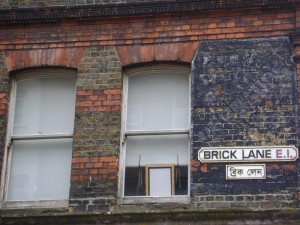 People always view progress as a positive thing, because, it means improvement for a community that means it. What I have learned being in London, is that progress has the potential to be something great, but at the expense of who? Professor Qualls has made me realize these past few days, is that the concept of progress is something beneficial, to a specific group, but at the expense of who? In order for true progress to be made a specific group must pay. Looking at the east end, it is obvious that the area is becoming economically improved, but at the expense of the middle and working classes in the area. The area is beginning to see major improvements, in both the markets and financial district, but the lower classes are taking a beating, because soon they will not be able to afford the area in which they live, and will be forced to move out. In essence this is progress in its truest form. However, it felt surreal to be in an area in which we have read so much about, and viewing the drastic changes in the area, gave me a sense of joy, but this emotion was balanced with a sense of sadness because of the effects this had on the community.
People always view progress as a positive thing, because, it means improvement for a community that means it. What I have learned being in London, is that progress has the potential to be something great, but at the expense of who? Professor Qualls has made me realize these past few days, is that the concept of progress is something beneficial, to a specific group, but at the expense of who? In order for true progress to be made a specific group must pay. Looking at the east end, it is obvious that the area is becoming economically improved, but at the expense of the middle and working classes in the area. The area is beginning to see major improvements, in both the markets and financial district, but the lower classes are taking a beating, because soon they will not be able to afford the area in which they live, and will be forced to move out. In essence this is progress in its truest form. However, it felt surreal to be in an area in which we have read so much about, and viewing the drastic changes in the area, gave me a sense of joy, but this emotion was balanced with a sense of sadness because of the effects this had on the community.
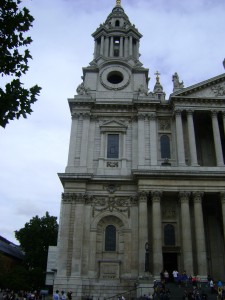 We later travelled to St. Pauls’ lead by our fabulous tour guide John. John was our tour guide for the West Minster Abbey, and because he did such an amazing job, professor Qualls decided John was more than capable to lead us in this national land mark of London. Once we all had arrived John began speaking about the birth of the St. Pauls’ Cathedral and the route and the history of its name. One thing Jon said before entering that I didn’t agree with was when he said, “be mindful that this place is still a church so please be mindful.” Once I entered St. Paul’s cathedral, I immediately noticed the outrageous fee to enter this “church.” I could not help but see this ever apparent contradiction, in that museum cost money, and churches are supposed to be free. Not only that but the electronic tour guides, and the amount of people who just seemed interested in looking at its architecture rather than praising god could have not convinced me more, that this Cathedral had lost its “holiness” a long time ago, at least in my opinion. My perceptions of St. Paul as a tourist attraction, however, were nothing but positive. The architecture was beautiful, and its history was astounding. As I climbed the steps of St. Pauls’ I could not help but think that in the immediate future I would be on the top of the city.
We later travelled to St. Pauls’ lead by our fabulous tour guide John. John was our tour guide for the West Minster Abbey, and because he did such an amazing job, professor Qualls decided John was more than capable to lead us in this national land mark of London. Once we all had arrived John began speaking about the birth of the St. Pauls’ Cathedral and the route and the history of its name. One thing Jon said before entering that I didn’t agree with was when he said, “be mindful that this place is still a church so please be mindful.” Once I entered St. Paul’s cathedral, I immediately noticed the outrageous fee to enter this “church.” I could not help but see this ever apparent contradiction, in that museum cost money, and churches are supposed to be free. Not only that but the electronic tour guides, and the amount of people who just seemed interested in looking at its architecture rather than praising god could have not convinced me more, that this Cathedral had lost its “holiness” a long time ago, at least in my opinion. My perceptions of St. Paul as a tourist attraction, however, were nothing but positive. The architecture was beautiful, and its history was astounding. As I climbed the steps of St. Pauls’ I could not help but think that in the immediate future I would be on the top of the city.
 Once I arrived the scenery was amazingly beautiful, I had never seen such an astounding sight. I was able to view London from an entirely different vantage point, and in doing so, I realized the true beauty of this chaotic city. I realized that, London, was the only city I have ever been to that had such an interesting personality, from the people, to its appearance, its multifaceted diversity was something that out of a book. It was something I will not soon forget!!!
Once I arrived the scenery was amazingly beautiful, I had never seen such an astounding sight. I was able to view London from an entirely different vantage point, and in doing so, I realized the true beauty of this chaotic city. I realized that, London, was the only city I have ever been to that had such an interesting personality, from the people, to its appearance, its multifaceted diversity was something that out of a book. It was something I will not soon forget!!!
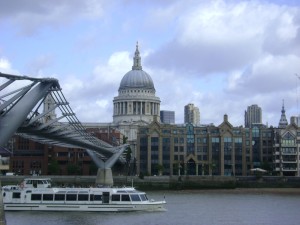
Tags: Anthony
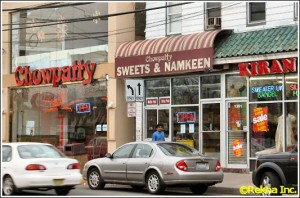
"Little India"
I haven’t missed home much during the past two weeks. We have been so busy with tours and museums and plays that I simply haven’t had time to be homesick–until yesterday and today. London’s East End and Southall reminded me so much of my hometown that I couldn’t help but long for good old Iselin, a place I took for granted before I came to college.
The town I’m from is extremely diverse and has a large South Asian population. For example, the top languages spoken in my high school (as of 2008) are English, Gujarati, Spanish, Urdu, Panjabi, Hindi, and Tagalog. Oak Tree Road and Green Street, the two main roads running through Edison and Iselin, NJ are lined with sari shops, curry houses, cash and carries, and more. The annual India Day Parade is the biggest event around and Bollywood stars are commonplace on billboards.
Growing up, I never really realized or appreciated the cultural diversity I experienced on an everyday basis. Even though the Indian/Bengali population has left the greatest mark on my area, there are numerous people of other backgrounds who reside in my area. The example I often use to make this point is if you come to visit me, I can find ANY kind of restaurant you can think of (Indian, Japanese, Chinese, Thai, Greek, Mexican, Spanish, Kosher, Portuguese, Mongolian, Polish, and Ethiopian are the ones I can list off the top of my head). Before coming to Dickinson and Carlisle, I never really thought about how much of the rest of the United States is, in fact, not like this at all.
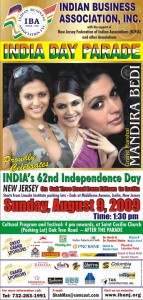
Advertisement for the India Day Parade on Oak Tree Rd.
Living in such a culturally diverse place has not always led to positive experiences. As we’ve seen and heard of in London, there is a lot of ethnic tension in my area due the sudden boom of immigrants that started in the 1990s. I’ve heard my friend’s parents refer to their neighbors as the “terrorists down the street,” and “dot-heads,” “deets,” and “hajis,” are only a few of the pejorative terms heard on a regular basis. I remember one of the blog posts mentioned an altercation between a white man and a South Asian man in a market, which reminded me of a time I was in the Target by my house and a white man shouted at the Indian man in front of him in line to, “go take a fucking shower and come back when you know some fucking English.” Another friend’s mother claimed that the Indians “stole” our Christmas light and use them for their holidays, disregarding the fact that Diwali is the Festival of Lights and electric lights are common decorations for purposes other than Christmas. I’ve even lost one friend within the past year because I refused to put up with his increasingly racist comments any longer.
I hope that this relatively new immigrant group will in time become more accepted in both American and British society. However, I might be rather pessimistic or cynical, as I can’t help but think that a new population will replace the lowest rung on the social ladder once this is allowed to move up. What I know for sure, though, is that all I can do is my part to try to fight intolerance and racism so that people might realize all of the wonderful things various cultures have to offer.
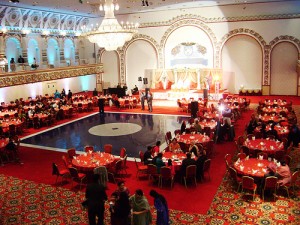
Royal Albert's Palace--An Indian catering hall where my friend had her Sweet 16
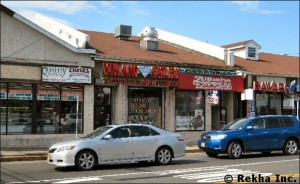
Oak Tree Road
Tags: Sarah
Through reading the syllabus beforehand, yesterday and today were two days I was most looking forward to on this trip. Two semesters ago I had taken a class called, What is Hinduism?, at Dickinson and there my love and appreciation for any kind of religion has grown. I was really excited to go to the Sikh temple today because I have some background knowledge on religions in India.
What most interested me in both some parts of Hinduism and Sikhism is their desire to eliminate distractions from your life. I find this task very admirable, being that I am constantly distracted in general and have trouble focusing, even at church. I know with Hinduism that to achieve this goal is called moksha, to be liberated from the cycle of life or samsara through reincarnation (which is generally thought of as a bad thing in Hinduism). To try to explain complicated concepts of Hinduism in two sentences is not easy, so for more information I suggest you look here. Sikhism as well seeks to achieve salvation through disciplined meditation in order to understand God and His messages. I have tried meditation once in my life and I know how difficult it was for me to focus on nothing or on one thing without getting distracted by a fleeting thought. I have such a deep respect for those that can devote their lives to meditation and focusing solely on their religion. At one point our guide was telling us about the five types of distractions that hinder your devotion to God. These distractions are called Maya or “unreality” and are known as greed, lust, ego, attachment and anger. It was interesting to see that parallel to our very similar “seven deadly sins.”
Another part of the day that I enjoyed was how the temple was so simple and uncluttered. After going to both St. Paul’s and Westminster Abbey, where the entire church is filled with statue, memorials, graves, etc it was a nice change to see just plain white walls. Even in the Hindu temple I had been in before, the walls still had big paintings of gods like Krishna. The Sikh temple made it easier to focus on the beauty of their religion, through the lovely songs of devotion drifting in and out of your consciousness and hardly any forms of art to distract you from paying attention and meditating.
What really saddened me in the end was how people can have such a negative impression when they see someone wearing a turban or any sort of South Asian clothing without knowing their background. They probably wouldn’t even know that they maybe are a Sikh, a very welcoming and passive community and religion. Reading in the pamphlet our tour guide gave to us, a quote stuck out to me. A man comments upon the Sikh community as being “very large hearted” and that “in spite of racial differences they co-exist with others happily.” As much as I felt like I stuck out in the temple, I felt a sense of welcome despite my awkward feeling. The fact that they allow anyone to come in and eat, Sikh or non-Sikh, is very nice of them. I would have thought that they wouldn’t want any outside influences, but instead they welcomed it. Even when I went to the Hindu temple before, the people there were so open and willing to teach us about their religion and have us participate. It is days like today that I realize how beautiful religion can sometimes be.
Tags: Alli
Today’s walk to the East End was a new and different experience for me. Having grown up in a middle class, white, rural area it was wonderful to actually see the complete opposite of the area in which I grew up. As much as I love ethnic street fairs and pan-asian food I had never really seen an area so completely different from the one I am used to.
When I read Salaam, Brick Lane I had problems envisioning the actual street. As much as I enjoyed the book I still was picturing more of a slum than a habitable living area (Jack London’s quotes about murder and refuse didn’t help). Indeed, when the book was written things were much worse in that area than they are now, but it was still quite helpful for me to actually see the setting.
What struck me most was that even though the Gherkin could still be seen over the tops of the buildings, it actually felt like we were in a completely different city. Sadly most of the shops were closed due to Ramadan, but it is definitely a place I want to explore further.
However, it was surprising to see just how much it had changed since Mr. Hall wrote his book. From what he described I assumed Brick Lane to be little more than a slum. While not exactly the nicest neighborhood it was far from unpleasant. From the number of people in their mid-twenties that I saw wandering around it seems as though the area is an up-and-coming place. This is just another example of the ever changing demographic in this section of London. Instead of a new group of immigrants it seems to me that perhaps the next tenants will be young adults looking for their first apartment. From what I saw today I wouldn’t mind living there myself.
In contrast, this afternoon we took a tour of St. Paul’s Cathedral. It was quite a stark difference going from the rather poorer East End to the opulence of Christopher Wren’s masterpiece. While the entire tour was interesting, the highlight was definitely the trek up the dome. The view from the top was breathtaking. We were treated to a view of the whole of London spread out beneath us, and as segregated as parts of London are on the ground, from up that high there are no boundaries drawn between sections of the city. It is all just one big sprawling mass and there are no distinctions. It was a nice change from the racism we have been discussing during class.
It was a good day and I’d love to explore the East End further.
Tags: Campbell
When I was first told about the Notting Hill Carnival, I have to say I was quite excited about getting the opportunity to attend. However, I really had no idea what to expect. I was told it was the second biggest street festival in Europe, so naturally I thought it would be intense. When we arrived in the morning it seemed pretty dead. The rubbish in the streets told me the prior day must have been quite a good time. I am glad that one of my first discoveries was a 2 litre bottle of Strongbow cider; something I did not expect to see at all. Nonetheless, my initial reaction was one of disappointment. We just walked about looking for a place to sit in order to watch the inevitable parades.
Despite the disappointing morning, the carnival came to life as noon approached. The first thing we saw was a very diverse parade. The participants ranged from a person dressed in what appeared to be a wedding dress with attached skeletons and machine guns to dinosaurs, a snake/bird creature and Corona girls. It appeared like everyone was having a good time, but I was still expecting more people. Luckily, the crowds did begin to grow once we started walking around the neighborhood.
One aspect of the carnival which really interested me was the political graffiti. It seemed that almost all of it, from what I saw, was “leftist” in nature. Two in particular caught my eye. One was a banner of sorts with Che Guevara in the middle. Spray painted on the red background was “Who the f*ck is this” with the response “Surely not Che?” I thought this was very interesting and entertaining. The other piece of graffiti I enjoyed was just a quote spray painted on wood which said “In a democracy dissent is an act of faith.” Overall, I am glad I was able to spot the graffiti I did see and be able to capture it through a lens before it was washed away.
-
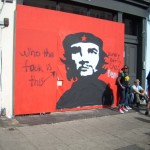
-
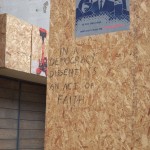
In the end, I really liked what I saw of the carnival. The food was simply amazing and very numerous. It was hard not to walk five feet and not spell something delicious being cooked. The parades were also fun to watch, especially the Jamaican one. Nevertheless, I still did expect more people. Though the crowds were pretty big, for the second largest street festival in Europe, I was disappointed at the amount of people. Of course, that does not mean I would not come back because it was an amazing experience and one I do not regret.
Tags: Andrew F









 People always view progress as a positive thing, because, it means improvement for a community that means it. What I have learned being in London, is that progress has the potential to be something great, but at the expense of who? Professor Qualls has made me realize these past few days, is that the concept of progress is something beneficial, to a specific group, but at the expense of who? In order for true progress to be made a specific group must pay. Looking at the east end, it is obvious that the area is becoming economically improved, but at the expense of the middle and working classes in the area. The area is beginning to see major improvements, in both the markets and financial district, but the lower classes are taking a beating, because soon they will not be able to afford the area in which they live, and will be forced to move out. In essence this is progress in its truest form. However, it felt surreal to be in an area in which we have read so much about, and viewing the drastic changes in the area, gave me a sense of joy, but this emotion was balanced with a sense of sadness because of the effects this had on the community.
People always view progress as a positive thing, because, it means improvement for a community that means it. What I have learned being in London, is that progress has the potential to be something great, but at the expense of who? Professor Qualls has made me realize these past few days, is that the concept of progress is something beneficial, to a specific group, but at the expense of who? In order for true progress to be made a specific group must pay. Looking at the east end, it is obvious that the area is becoming economically improved, but at the expense of the middle and working classes in the area. The area is beginning to see major improvements, in both the markets and financial district, but the lower classes are taking a beating, because soon they will not be able to afford the area in which they live, and will be forced to move out. In essence this is progress in its truest form. However, it felt surreal to be in an area in which we have read so much about, and viewing the drastic changes in the area, gave me a sense of joy, but this emotion was balanced with a sense of sadness because of the effects this had on the community. We later travelled to St. Pauls’ lead by our fabulous tour guide John. John was our tour guide for the West Minster Abbey, and because he did such an amazing job, professor Qualls decided John was more than capable to lead us in this national land mark of London. Once we all had arrived John began speaking about the birth of the St. Pauls’ Cathedral and the route and the history of its name. One thing Jon said before entering that I didn’t agree with was when he said, “be mindful that this place is still a church so please be mindful.” Once I entered St. Paul’s cathedral, I immediately noticed the outrageous fee to enter this “church.” I could not help but see this ever apparent contradiction, in that museum cost money, and churches are supposed to be free. Not only that but the electronic tour guides, and the amount of people who just seemed interested in looking at its architecture rather than praising god could have not convinced me more, that this Cathedral had lost its “holiness” a long time ago, at least in my opinion. My perceptions of St. Paul as a tourist attraction, however, were nothing but positive. The architecture was beautiful, and its history was astounding. As I climbed the steps of St. Pauls’ I could not help but think that in the immediate future I would be on the top of the city.
We later travelled to St. Pauls’ lead by our fabulous tour guide John. John was our tour guide for the West Minster Abbey, and because he did such an amazing job, professor Qualls decided John was more than capable to lead us in this national land mark of London. Once we all had arrived John began speaking about the birth of the St. Pauls’ Cathedral and the route and the history of its name. One thing Jon said before entering that I didn’t agree with was when he said, “be mindful that this place is still a church so please be mindful.” Once I entered St. Paul’s cathedral, I immediately noticed the outrageous fee to enter this “church.” I could not help but see this ever apparent contradiction, in that museum cost money, and churches are supposed to be free. Not only that but the electronic tour guides, and the amount of people who just seemed interested in looking at its architecture rather than praising god could have not convinced me more, that this Cathedral had lost its “holiness” a long time ago, at least in my opinion. My perceptions of St. Paul as a tourist attraction, however, were nothing but positive. The architecture was beautiful, and its history was astounding. As I climbed the steps of St. Pauls’ I could not help but think that in the immediate future I would be on the top of the city. Once I arrived the scenery was amazingly beautiful, I had never seen such an astounding sight. I was able to view London from an entirely different vantage point, and in doing so, I realized the true beauty of this chaotic city. I realized that, London, was the only city I have ever been to that had such an interesting personality, from the people, to its appearance, its multifaceted diversity was something that out of a book. It was something I will not soon forget!!!
Once I arrived the scenery was amazingly beautiful, I had never seen such an astounding sight. I was able to view London from an entirely different vantage point, and in doing so, I realized the true beauty of this chaotic city. I realized that, London, was the only city I have ever been to that had such an interesting personality, from the people, to its appearance, its multifaceted diversity was something that out of a book. It was something I will not soon forget!!!





